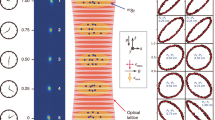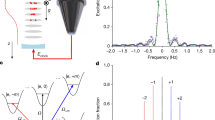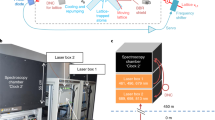Abstract
The local position invariance principle of general relativity stipulates that non-gravitational experiments should give outcomes that are independent of the position and orientation of the reference frames in which they have been performed. Here, we study the change in the rates of clocks on Earth with the spatial change of the solar potential, constraining the variation of a non-gravitational interaction—the hyperfine splitting in hydrogen and caesium atoms—to β = (2.2 ± 2.5) × 10−7, a factor of two improvement over previous estimates. Our result is based on the comparison between the long-term fractional frequency variation of four hydrogen masers that are part of an ensemble of clocks comprising the National Institute of Standards and Technology, Boulder, and the fractional frequencies of primary frequency standards operated by leading metrology laboratories in the United States, France, Germany, Italy and the United Kingdom over a period of more than 14 years. Using our results together with the previous best estimates of β, we impose strict limits on the variation of fundamental constants, resulting in a test of general relativity with an unprecedented level of precision.
This is a preview of subscription content, access via your institution
Access options
Access Nature and 54 other Nature Portfolio journals
Get Nature+, our best-value online-access subscription
$29.99 / 30 days
cancel any time
Subscribe to this journal
Receive 12 print issues and online access
$209.00 per year
only $17.42 per issue
Buy this article
- Purchase on Springer Link
- Instant access to full article PDF
Prices may be subject to local taxes which are calculated during checkout



Similar content being viewed by others
References
Einstein, A. The Collected Papers of Albert Einstein, Volume 6: The Berlin Years: Writings, 1914–1917 (Princeton Univ. Press, Princeton, NJ, 1996).
DeMille, D., Doyle, J. M. & Sushkov, A. O. Probing the frontiers of particle physics with tabletop-scale experiments. Science 357, 990–994 (2017).
Will, C. M. The confrontation between general relativity and experiment. Living Rev. Relativ 9, 3 (2014).
Dicke, R. H. Experimental Relativity: Lectures delivered at Les Houches, 1963; Relativity, Groups and Topolo gy (eds DeWitt, C. and DeWitt, B.) (Gordon & Breach, New York, NY, 1964).
Sullivan, D. B. Time and frequency measurement at NIST: the first 100 years. In Proc. 2001 IEEE International Frequency Control Symposium, Cat. No. 01CH37218, 4–17 (IEEE, Piscataway, NJ, 2001).
Ashby, N. et al. Testing local position invariance with four cesium-fountain primary frequency standards and four NIST hydrogen masers. Phys. Rev. Lett. 98, 070802 (2007).
Levi, F. et al. Accuracy evaluation of ITCsF2: a nitrogen cooled caesium fountain. Metrologia 51, 270–284 (2014).
Jefferts, S. R. et al. Accuracy evaluation of NIST-F1. Metrologia 39, 321–336 (2003).
Weyers, S., Hubner, U., Schroder, R., Tamm, C. & Bauch, A. Uncertainty evaluation of the atomic caesium fountain CSF1 of the PTB. Metrologia 38, 343–352 (2001).
Gerginov, V. et al. Uncertainty evaluation of the caesium fountain clock PTB-CSF2. Metrologia 47, 65–79 (2010).
Szymaniec, K. et al. NPL Cs fountain frequency standards and the quest for the ultimate accuracy. J. Phys. Conf. Ser. 723, 012003 (2016).
Guéna, J. et al. Progress in atomic fountains at LNE-SYRTE. IEEE Trans. Ultrason. Ferroelectr. Freq. Control 59, 391–410 (2012).
Reports of Evaluation of Primary Frequency Standards (BIPM, accessed 14 March 2017); http://www.bipm.org/en/bipm-services/timescales/time-ftp/data.html
Folkner, W. M., Williams, J. G., Boggs, D. H., Park, R. S. & Kuchynka, P. The Planetary and Lunar Ephemerides DE430 and DE431 InterPlanetary Network Progress Report 42–196 (IPN, 2014).
Guéna, J. et al. Improved tests of local position invariance using Rb87 and Cs133 fountains. Phys. Rev. Lett. 109, 080801 (2012).
Peil, S., Crane, S., Hanssen, J. L., Swanson, T. B. & Ekstrom, C. R. Tests of local position invariance using continuously running atomic clocks. Phys. Rev. A 87, 010102(R) (2013).
Uzan, J. The fundamental constants and their variation: observational and theoretical status. Rev. Mod. Phys. 75, 403–455 (2003).
Fischer, M. et al. New limits on the drift of fundamental constants from laboratory measurements. Phys. Rev. Lett. 92, 230802 (2004).
Flambaum, V. V. & Tedesco, A. F. Dependence of nuclear magnetic moments on quark masses and limits on temporal variation of fundamental constants from atomic clock experiments. Phys. Rev. C 73, 055501 (2006).
Dinh, T. H., Dunning, A., Dzuba, V. A. & Flambaum, V. V. Sensitivity of hyperfine structure to nuclear radius and quark mass variation. Phys. Rev. A 79, 054102 (2009).
Dzuba, V. A. & Flambaum, V. V. Limits on gravitational Einstein equivalence principle violation from monitoring atomic clock frequencies during a year. Phys. Rev. D 95, 015019 (2017).
Godun, R. M. et al. Frequency ratio of two optical clock transitions in 171Yb+ and constraints on the time variation of fundamental constants. Phys. Rev. Lett. 113, 210801 (2014).
Huntemann, N. et al. Improved limit on a temporal variation of m p/m e from comparisons of Yb+ and Cs atomic clocks. Phys. Rev. Lett. 113, 210802 (2014).
Ludlow, A. D., Boyd, M. M., Ye, J., Peik, E. & Schmidt, P. O. Optical atomic clocks. Rev. Mod. Phys. 87, 637–701 (2015).
Lisdat, C. et al. A clock network for geodesy and fundamental science. Nat. Commun. 7, 12443 (2016).
Nicholson, T. L. et al. Systematic evaluation of an atomic clock at 2 × 10−18 total uncertainty. Nat. Commun. 6, 6896 (2015).
Schioppo, M. et al. Ultrastable optical clock with two cold-atom ensembles. Nat. Photon. 11, 48–52 (2017).
Tobar, M. E. et al. Testing local position and fundamental constant invariance due to periodic gravitational and boost using long-term comparison of the SYRTE atomic fountains and H-masers. Phys. Rev. D 87, 122004 (2013).
Parker, T. E., Jefferts, S. R., Heavner, T. P. & Donley, E. A. Operation of the NIST-F1 caesium fountain primary frequency standard with a maser ensemble, including the impact of frequency transfer noise. Metrologia 42, 423–430 (2005).
Panfilo, G. & Parker, T. E. A theoretical and experimental analysis of frequency transfer uncertainty, including frequency transfer into TAI. Metrologia 47, 552–560 (2010).
Turneaure, J. P., Will, C. M., Farrell, B. F., Mattison, E. M. & Vessot, R. F. C. Test of the principle of equivalence by a null gravitational red-shift experiment. Phys. Rev. D 27, 1705–1714 (1983).
Godone, A., Novero, C. & Tavella, P. Null gravitational redshift experiment with nonidentical atomic clocks. Phys. Rev. D 51, 319–323 (1995).
Heß, M. P. et al. The ACES mission: system development and test status. Acta Astronaut. 69, 929–938 (2011).
Altschul, B. et al. Quantum tests of the Einstein equivalence principle with the STE-QUEST space mission. Adv. Space Res. 55, 501–524 (2015).
Vessot, R. F. C. et al. Test of relativistic gravitation with a space-borne hydrogen maser. Phys. Rev. Lett. 45, 2081–2084 (1980).
Parker, T. E. Environmental factors and hydrogen maser frequency stability. IEEE Trans. Ultrason. Ferroelectr. Freq. Control 46, 745–751 (1999).
Lewis, L. L. An introduction to frequency standards. Proc. IEEE 79, 927–935 (1991).
Acknowledgements
We acknowledge funding from NASA grant NNH12AT81I. We also thank the atomic standards group at NIST for maintaining the H masers and sharing the data. We thank E. Donley, S. Jefferts and C. Oates for providing valuable suggestions that have helped improve this paper. We thank J. Sherman and J. Ye for discussing the planned clock comparisons between NIST and JILA. This work is a contribution of NIST and is not subject to US copyright.
Author information
Authors and Affiliations
Contributions
T.E.P. compiled data from BIPM and analysed maser versus primary frequency standard data. N.A. and B.R.P. carried out the data analysis and performed the calculations that were the basis of the main conclusions of this paper. B.R.P. wrote the manuscript with input from all of the authors, and all authors discussed the results and the conclusions.
Corresponding author
Ethics declarations
Competing interests
The authors declare no competing interests.
Additional information
Publisher’s note: Springer Nature remains neutral with regard to jurisdictional claims in published maps and institutional affiliations.
Supplementary information
Supplementary Information
Supplementary notes, Supplementary Tables 1,2, Supplementary Figure 1 and references
Rights and permissions
About this article
Cite this article
Ashby, N., Parker, T.E. & Patla, B.R. A null test of general relativity based on a long-term comparison of atomic transition frequencies. Nature Phys 14, 822–826 (2018). https://doi.org/10.1038/s41567-018-0156-2
Received:
Accepted:
Published:
Issue Date:
DOI: https://doi.org/10.1038/s41567-018-0156-2



